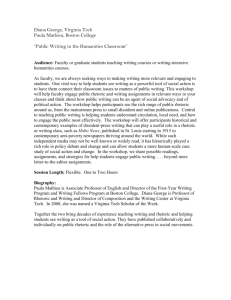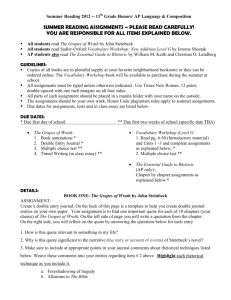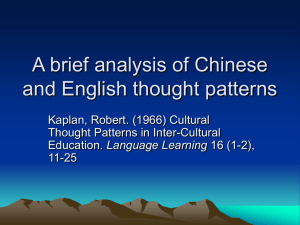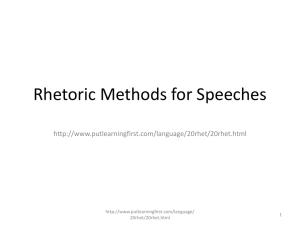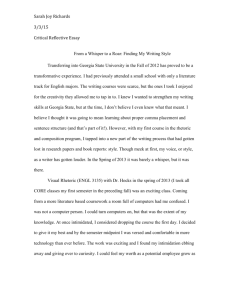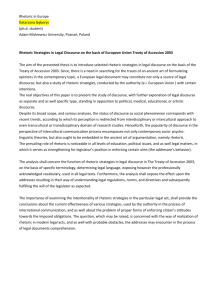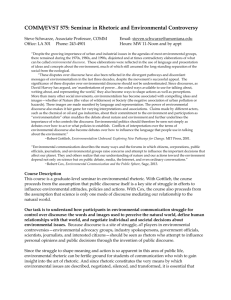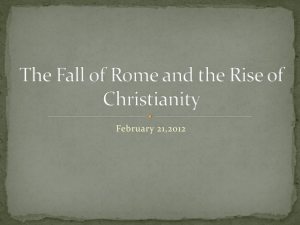Rhetoric, identity, and presentation in the first year
advertisement
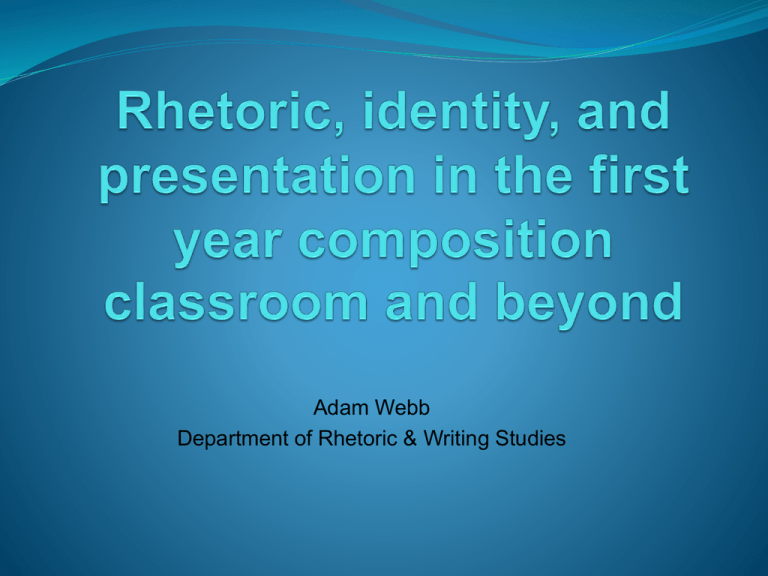
Adam Webb Department of Rhetoric & Writing Studies Activity Before I begin, I would like for us to answer these two questions below: What is writing? What is research? During the course of the presentation, let us see if our answers, responses, and concerns can provide a framework for future discussion… Purpose I am actually proposing a new approach for composition and writing instructors that involves the teaching of primary research techniques, centered in a community-based and career/professional framework of writing activities and assignments. My argument is centered in the idea that writing is a social and collaborative act. By participating in a “culture of writing,” where writing is viewed as a situated and dynamic activity, students create discourse and are also created by that discourse. Four factors to consider… A focus on primary research strategies (rhetorically contextual) An emphasis on teaching more of a social sciences and hard sciences approach to research and writing (discourse identity) Writing as a “performing” act (“knowledge presentation”) Writing and technology (social networks) Rhetoric(s) is (are)… Persuasion? Flattery? Art? Craft? Skill? Style? Strategically, situated discourse? (George E. Marcus, 1995, ethnography; Helen Foster, 2009, rhetoric and writing studies) Rhetoric… “In short, rhetoric is a mode of altering reality, not by the direct application of energy to objects, but by the creation of discourse which changes reality through the mediation of thought and action” (Lloyd F. Bitzer, 1968, p. 4) “The study of how people use language and other symbols to realize human goals and carry out human activities . . . ultimately a practical study offering people great control over their symbolic activity” (Charles Bazerman, 1988, p. 6) “...rhetoric is the process of using language to organize experience and communicate it to others. It is also the study of how people use language to organize and communicate experience. The word denotes…both distinctive human activity and the ‘science’ concerned with understanding that activity” (C. H. Knoblauch, 1985, p. 29) Identity(ies) Individually constructed? Socially constructed? Digital/Virtual persona? What goes into an “identity?” Identity(ies) “Academic writing, like all forms of communication, is an act of identity: it not only conveys disciplinary ‘content’ but also carries a representation of the writer” (Ken Hyland, 2002, p. 1092) “[Roz] Ivanic admits that identity can be seen as ‘the outcome of previous experiences’ or as the way individuals ‘position themselves in an act of (discourse),’ she argues that ‘there can be no evidence for (the former) other than (the latter)’” (Julia Menard-Warwick, 2005, p. 264 after Ivanic, 1998, p. 105) Presentation Of knowledge? Of information? Of images? Of texts? Of self? Presentation Peter Storkerson’s (2003) model of “Knowledge Presentation:” Model retrieved from Google Images, 2010. Rhetoric, identity, and presentation… Rhetorics – Plural, challenges the Western idea of how to form and structure an “argument” … definitely challenges the notion of what “academic writing” is and methods of research Identity as fluid and multiple-disciplinary, extends beyond the classroom and the academy Presentation of knowledge – Students as “knowledge- makers” is central to their forming and using language in making arguments and in their writing (Deans, 2006, preface, xxi) Suggestions, research needed… Look at writing and research taught outside of the English Department (i.e. Possibly have rhetoric and writing majors “train” in how to teach writing and research from a multidisciplinary perspective) Examine writing and research activities and assignments taught from a multi-disciplinary perspective (i.e. how primary and secondary research methods are taught, what activity and assignment sequences are used, etc.) Examine writing and research activities and assignments taught from a multi-disciplinary perspective (i.e. how primary and secondary research methods are taught, what activity and assignment sequences are used, etc.) Suggestions, instructors needed… Encourage more collaboration and involvement from individuals from other disciplines to inform and influence the way in which writing and research is taught (i.e. offer interdisciplinary workshops) Train composition and writing instructors how to do their own “in-class” (action) research (i.e. Anne Ruggles Gere, 1985, “Empirical Research in Composition,” pp.110-24) Allow/incorporate individuals outside of English Studies to teach writing and research in the First-Year Program (i.e. Composition, technical writing, advanced composition, etc.) Suggestions, pedagogy needed… Look at designing and developing more interactive writing and research activities and assignments (i.e. “multi-layered” writing assignments that require students to shift modes of research and writing strategies within the same assignment) Incorporation of more writing and research activities and assignments that focus on the students’ careers or future professions (i.e. various kinds of disciplinary writing and research strategies, reflective writing assignments) Increased use of technology (i.e. computers, but also the use of other technological devices and programs) in the teaching of research and writing Incorporation of service-learning projects into the curriculum (i.e. hands-on approach, applying what the students are learning in the classroom to real life) Final suggestion, future needed… Develop “writing and research” courses outside of the First-Year Program as an option for students (i.e. a true “writing-in-the-sciences research and writing course” … develop new courses centered around research and writing) Factors for consideration Primary and secondary research strategies Social sciences and hard sciences approach to research and writing Writing as a “performing” act Use of online programs (social networks) Questions? And Thank you!
